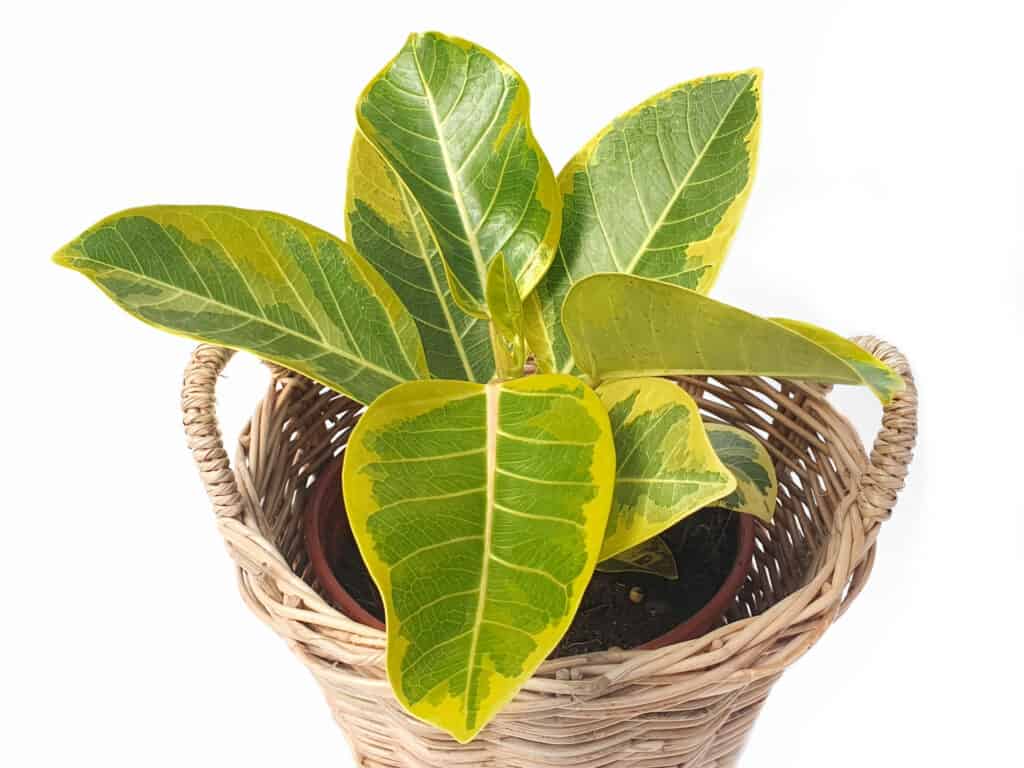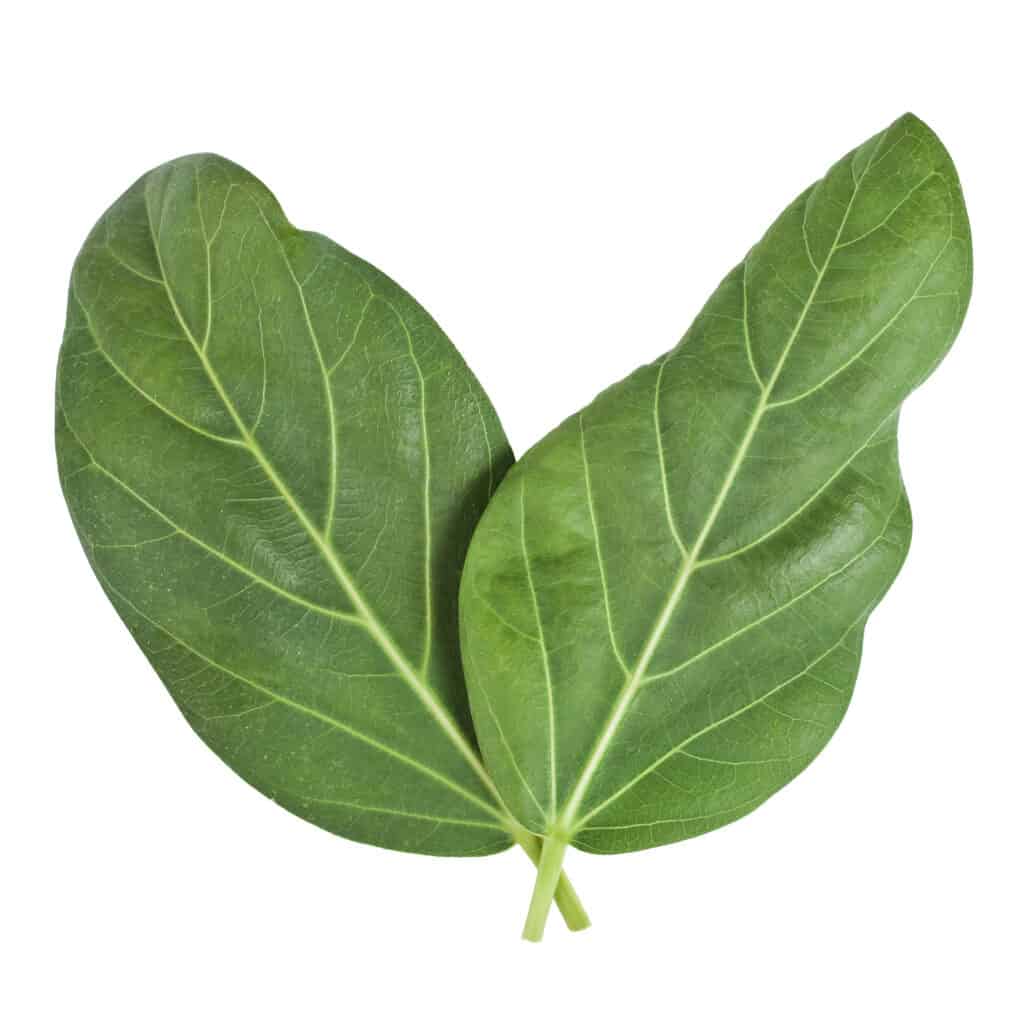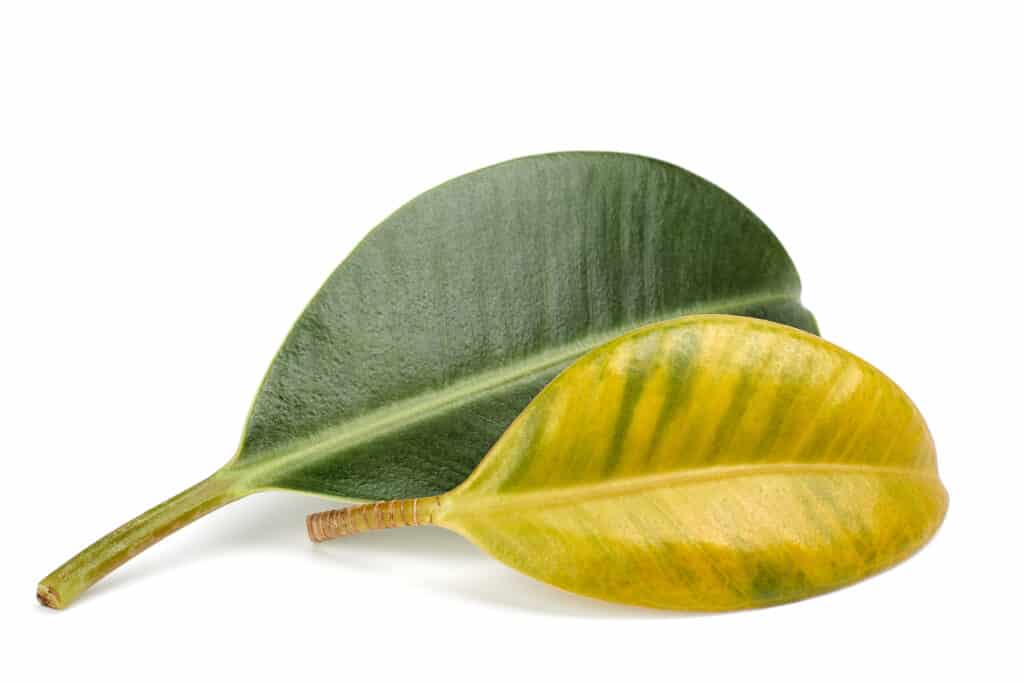Ficus Altissima and Audrey are two very similar ficus plants that love growing indoors. They are difficult to tell apart, but there is one obvious difference aside from their native origins. Let’s take a closer look at Ficus Altissima vs. Audrey.
Main Difference Between Ficus Altissima vs. Audrey
The main difference between Ficus Altissima and Audrey is the foliage. Ficus Altissima has pointed green veined ovals with dark green to light green shades, but Audrey has rounded green foliage with pale veins.
Ficus Altissima vs. Audrey: Origins

iStock.com/Nemo1024
Ficus Altissima is a species of fig tree in the Moraceae family. It’s native to the southeast Asian forests and better known as the Council Tree. Ficus Altissima is an evergreen tree that grows up to 100 feet in height, but when it’s a house plant it usually maxes out at six feet.
It was found by Dutch explorer and botanist Carl Ludwig Blume in 1862. Since then, it’s naturalized in Florida and its popular cultivar Yellow Gem has dominated the Altissima market.
Audrey on the other hand is a Ficus benghalensis cultivar. Ficus benghalensis is a species of Indian fig tree that also grows up to 100 feet tall in the wild. It’s the national tree of India and its cultivar Audrey is a very popular houseplant. Audrey is a horticultural cultivar developed by botanists and doesn’t grow in the wild, but its parent plant does.
Growth Habit: Ficus Altissima vs. Audrey
Both of these plants are evergreen strangler figs. They’re called this because of their disturbing growth habit! They start life in the branches of a tree, often a crape myrtle or a palm, as an epiphyte absorbing nutrients from the air and rain.
As Ficus Altissima and Audrey grow, they drape their roots toward the ground, twisting their way around their host’s trunk. When they touch down, they root into the soil to take nutrients directly and grow strong enough to support themselves.
During this process they end up killing the host tree, leaving the ficus tree to stand alone above the soil line on towering stilt roots.

iStock.com/Nalin Prutimongkol
Ficus Altissima vs. Audrey: Height and Spread
In the wild, Audrey’s parent plant Ficus benghalensis can reach 100 feet tall and it’s capable of growing wider. Some species are recorded at over 150 feet wide! They are huge trees in the wild, but houseplants reach about six feet.
Ficus Altissima also reaches 100 feet in height and spread in the wild, and six feet when it’s a houseplant.
Ficus Altissima vs. Audrey: Origins
Ficus Altissima is native to the tropics of Southeastern Asia and the Pacific Ocean islands, whereas Audrey’s parent plant, Ficus benghalensis, is native to Pakistan, India, and Sri Lanka.
Are Ficus Altissima and Audrey Epiphytes?
No, but they are half-epiphytes or hemiepiphytes! Altissima and Audrey are strangler fig hemiepiphytes, which are plants that spend only part of their lifecycle as epiphytes.
Epiphytes are plants that live on another plant’s surface, and they take their nutrients from the air, rain, and debris that falls near them. They aren’t quite parasites because they don’t take anything from the host plant.
Hemiepiphytes germinate and live their early life in a tree canopy but when they make contact with the soil they grow as rooted vines. Even though Ficus Altissima and Audrey aren’t parasitic, they often kill the host plant by blocking out light and competing for water.
Ficus Altissima vs. Audrey: Foliage
These two ficus trees have similar foliage, but there are a few differences.

iStock.com/MilenaKatzer
Altissima has shiny, thick, dark green leaves with a delicate veined pattern. It has a woody stem with short branches and its leathery leaves are pointed ovals. Altissima has a cultivar called Yellow Gem, which is a yellow and green variegated version. Quite often the Yellow Gem cultivar is referred to as simply ‘Altissima’.
In contrast, Audrey has thick, green, rounded leaves with pale, creamy-green veins. The best way to tell the difference between Ficus Altissima and Audrey is that Altissima has thicker, pointed foliage.
Ficus Altissima vs. Audrey: Light Requirements
When they’re grown as houseplants, ficuses can be a little temperamental if they’re moved and often drop all their leaves in protest. They will grow back, so don’t throw these plants away!
Because both Altissima and Audrey are tropical plants that grow in tree canopies they love bright, indirect light. If you put one on a windowsill and the sun bakes it, then its thick leathery leaves will burn and blister. Near a bright east-facing window is the best spot.
They also need plenty of humidity, so a weekly misting will really help them unless you grow ficus in a bright steamy bathroom where it will flourish in the warmth.
Do Ficus Houseplants Have Flowers?
Ficus houseplants don’t usually flower, but in the wild, they have strange-looking blooms. Their flowers are tiny, white, and almost totally hidden inside a hollow receptacle that eventually turns into fruit. Although they are tiny and hidden, this doesn’t stop pollinator fig wasps from finding them!
Pruning Ficus Altissima and Audrey
Ficus Altissima and Audrey don’t need pruning, but if you want to manage their size then you can remove a few branches.
Thinning out congested ficus foliage improves airflow and beats the powdery mildew that can sometimes occur, but don’t take out more than 10-15% of the foliage, or the plant may go into shock and drop its leaves — ficus plants are quite temperamental! Be sure to wear gloves because Ficus Altissima’s and Audrey’s sap is an irritant.
Any brown or dying leaves can be clipped off near the stem at any point in the year, but when you remove healthy foliage don’t throw it away because clippings can be propagated into free ficus plants.

iStock.com/EkaterinaZakharova
How To Grow A New Ficus From A Cutting
Growing a new Ficus Altissima or Audrey from a clipping is easy. Just follow these steps.
- Fill a glass with clean water
- Put the clipping stem in the water
- Remove any leaves that sit below the waterline
- Change the water once or twice a week
After three to four weeks, or sometimes even two months, tiny white roots will emerge from the stem! Be patient. It takes time because ficus trees are in no rush to grow.
When the new roots reach an inch in length, put the baby ficus in a container of potting soil and keep it moist, but not soaking, on a bright, indirectly lit windowsill. Turn the baby each week so it gets sunlight on all sides and grows evenly.
Why Does My Ficus Have Yellow Leaves?

iStock.com/Lari Bat
Yellow leaves are a sign that your Ficus Altissima or Audrey is not happy. There are a few reasons for yellowing foliage including overwatering, not enough light, and nutrient deficiency.
The most common reason is overwatering. A ficus doesn’t need water unless the soil is dry down to a few inches. When you come to water it, don’t pour from the top, instead, take the pot and place it in a sink of water. Let it soak up the liquid for a few hours and then leave it on a draining board to drain excess water off.
Inadequate light is solved by moving your Ficus Altissima or Audrey to a brighter spot, but ensure that it is still in indirect light to avoid leaf burn.
Finally, when did you last fertilize it? After a few months, houseplants use up the container soil’s nutrients and need more. Buy a ficus fertilizer and use it according to the instructions from spring to fall when the plant is actively growing. If you can see roots poking through the drainage holes, then you’ll need to re-pot it as well.
Are Ficus Houseplants Toxic to Pets?
Ficus Altissima and Audrey are mildly toxic if their foliage is chewed, so it’s best to keep them out of the reach of children and pets. Symptoms include dribbling, vomiting, and diarrhea.
Which Is Best: Ficus Altissima vs. Audrey?
Both of these ficus plants are beautiful and easy to grow. There are a few differences in their foliage, so the best one really depends on your preference. Altissima has pointed dark to light green ovals whereas Audrey has light green rounded ovals with paler veining.
The choice is yours!
Up Next:
- Parlor Palm vs. Areca Palm: What’s the Difference?
- Poison Ivy vs. English Ivy
- Heartleaf Philodendron vs. Pothos: What is the Difference?
The post Ficus Altissima vs. Audrey appeared first on AZ Animals.
from Animal News, Facts, Rankings, and More! - AZ Animals https://ift.tt/YCOcEg5